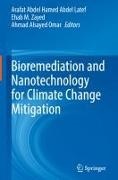Ulteriori informazioni
This book integrates various scientific approaches, including bioremediation and nanomaterials, to address environmental challenges posed by living organisms. It serves as a crucial guide for decision-makers, providing a scientific foundation for tackling issues within the circular economy paradigm. By introducing innovative methods for improving environmental conditions, the book facilitates the design of eco-friendly cities and revitalizes older urban areas. The chapters cover topics such as the current state and future of international environmental relations, the impact of population growth on pollution, and recent advances in sustainable waste management. Readers will discover insights into the relationship between air pollution, nanomaterials, and bioremediation, as well as the role of artificial intelligence as a predictive tool. The book also explores key pollution-related issues and presents effective remediation strategies. Special attention is given to the role of nanotechnology in addressing climate change, with chapters highlighting its applications in sustainable agriculture. This book is an invaluable resource for professionals, researchers, and graduate students engaged in advanced environmental science research. It reinforces fundamental remediation concepts while introducing the latest updates, maximizing readers' knowledge of sensor-based remediation. The book presents a multidisciplinary approach, integrating theoretical perspectives with practical case studies. Whether the reader is an academic, practitioner, or interested layperson, this book offers a wealth of information and insights into the future of environmental sustainability.
Sommario
.- Chapter 1:The current situation and future of international relations in environmental issues and climate change.- Chapter 2: Increased population is a source of environmental pollution and climate change .- Chapter 3: Types of fumes, vapors and gases and a vision to overcome them.- Chapter 4: Types of running water, groundwater and polluted rain and a vision to overcome them .- Chapter 5: Recent advances in Sustainable Waste Management Practices.- Chapter 6: Agricultural Pollution and its Relation to Climate Change.- Chapter 7: History, Present, and Future of Recycling in Eliminating Environmental Pollution and Facing Climate Change.- Chapter 8: Different Types and Degrees of Wastewater Treatments - Present and Future.- Chapter 9: The Interplay Between Air Pollution, Nanomaterials, and Bioremediation .- Chapter 10: Water Pollution, Nanomaterials, and Bioremediation .- Chapter 11:Types of Water Desalination and Its Impact on Environmental Pollution and Climate Changes .- Chapter 12:Recycling Environment and Bioremediation.- Chapter 13:Overview of Plastic and Bioremediation: Present Investigations and Future Outlook.- Chapter 14:Fuel Shipping and Bioremediation.- Chapter 15:Seas and Oceans Save by Bioremediation .- Chapter 16:Artificial Intelligence as bioremediation predictive tool .- Chapter 17:Remediation Policy and Management .- Chapter 18:Future of world health by bioremediation.- Chapter 19: Nanomaterial's remarkable characteristics majorly influence .- Chapter 20: Benefits of Nanotechnology in Dealing with Global Warming and Climate Change .- Chapter 21: The solar radiation's absorption in the photovoltaic cells in nanoparticles .- Chapter 22: Nanotechnology Reduces Global Warming .- Chapter 23: Nanotechnology: A Smart Approach for Sustainable Agriculture under Global Climate Change .- Chapter 24:Strategy, Global Warming, and Nanotechnologies.- Chapter 25: Future of nanotechnology and climate change.

